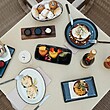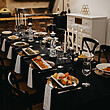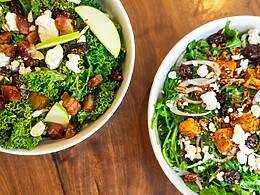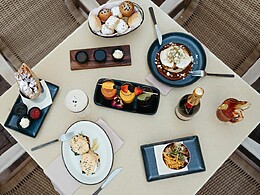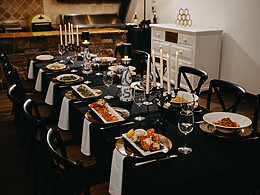
Did you know Feb. 23 was National Curling is Cool Day? How about that there is an aspiring Olympic curler here in the Valley who also happens to be the chef of Pasta Brioni and the new dining concept, NPX: A Neighborhood Joint? Well, it’s time to get schooled on this unique Olympic sport from chef Michael Siggins.
AFM: So, what is curling?
MS: Curling is an Olympic sport where two teams of four throw eight different 45-pound stones down a 150-ft. sheet of ice toward a 12-ft. diameter circular scoring zone called the “house” and strategically place them to score points against their opponent. It’s a game invented in Scotland, originally playing on frozen lakes and using stones from around the lake. It’s shuffleboard on ice, just much more complicated.
AFM: How did you get involved in the sport?
MS: I have always been a big supporter of the United States in any international competition, and because of that, I love the Olympics. I was home, sick during the 2006 Olympics, and curling was the only thing on. I had never heard of it, but the US was playing, so I decided to watch. I was so captivated by it that I watched every other game after that and invited a friend over to watch it with me. Before we knew it, we were googling curling in Arizona and found the Coyotes Curling Club. Once I learned to curl, I was hooked!
AFM: Are there any misconceptions about the sport that you want to clear up?
MS: Many don’t even know what curling is, and even amongst those that do, it’s not very well understood. For casual fans who have a basic understanding of it and at the hobby levels, it’s viewed much like bowling. Many view it as something that doesn’t require a lot of athletic ability. While that is true at the very basic levels and literally anyone can learn how to curl, at high levels, athleticism plays a crucial role. A good team of four will burn about 7,000 calories aggregately in a game and must have the stamina to perform consistently throughout an entire game or tournament.
AFM: How are you prepping for the Olympic team qualifications?
MS: We have a long way to go, and we’ve got a lot going against us. The organization that picks the teams for the Trials is geographically biased toward the upper Midwest, which is the hotbed of curling in the US. We have to travel and play in tournaments called cashspiels and earn points to guarantee a way into the Trials. There will be three or four teams that compete in the Trials in 2021. Right now, we’re probably around 12th or 13th in the country, so we have some work to do on our game as well between now and then. We practice, we play at our local curling club in Tempe, and we travel all over the world to play in these events to try to earn points.
AFM: Tell us about NPX, your newest restaurant.
MS: NPX: A Neighborhood Joint is just that, a neighborhood joint. Growing up in the North Phoenix area, I experienced firsthand what a great neighborhood and great people I had around me. I envisioned a restaurant that was not just a restaurant, but a community gathering place. I’m doing this by plugging into the community; we support our local high school sports teams, do endless givebacks for fantastic causes, and do our best to provide a family-friendly spot for all of those in this great neighborhood to come together and have some great food! From a culinary standpoint, this menu is the product of my experiences and note taking as a chef over the years, which is why everything on the menu has a story behind it. The fried Spam benedict was born on a curling trip. Ashley’s biscuit chili is named after my wife because she made me chili with biscuits in it one day, and I was amazed how great it was. Ray’s pot poast would be my latefather’s favorite. Tot Stop, Pittsburgh sandwich, Asian nachos, waffle chicken – they all have really cool stories behind them.
AFM: Curling and the culinary world—in what ways are they similar?
MS: Precision and consistency. To be a good curler and a good chef, you have to have great precision – in curling, it’s your delivery or the way you slide to throw the rock. It has to be precise. Recipes as well must be precise. In curling, consistently throwing the correct distance each time (called the “weight”) with the correct amount of rotations is paramount to being able to place the stone in the correct position. In a restaurant, if your food isn’t the same every time, you’re not going to last very long. Each batch of clam chowder needs to taste exactly the same every time, and that goes for every menu item for preparation to execution to plating.




